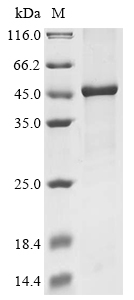Recombinant Mouse Ubiquitin carboxyl-terminal hydrolase CYLD (Cyld) , partial
CAT:
399-CSB-EP773899MO-01
Size:
1 mg
Price:
Ask
- Availability: 24/48H Stock Items & 2 to 6 Weeks non Stock Items.
- Dry Ice Shipment: No




Recombinant Mouse Ubiquitin carboxyl-terminal hydrolase CYLD (Cyld) , partial
- CAS Number: 9000-83-3
- Gene Name: Cyld
- UniProt: Q80TQ2
- Expression Region: 579-952aa
- Organism: Mus musculus
- Target Sequence: GLEIMIGKKKGIQGHYNSCYLDSTLFCLFAFSSALDTVLLRPKEKNDIEYYSETQELLRTEIVNPLRIYGYVCATKIMKLRKILEKVEAASGFTSEEKDPEEFLNILFHDILRVEPLLKIRSAGQKVQDCNFYQIFMEKNEKVGVPTIQQLLEWSFINSNLKFAEAPSCLIIQMPRFGKDFKLFKKIFPSLELNITDLLEDTPRQCRICGGLAMYECRECYDDPDISAGKIKQFCKTCSTQVHLHPRRLNHSYHPVSLPKDLPDWDWRHGCIPCQKMELFAVLCIETSHYVAFVKYGKDDSAWLFFDSMADRDGGQNGFNIPQVTPCPEVGEYLKMSLEDLHSLDSRRIQGCARRLLCDAYMCMYQSPTMSLYK
- Tag: N-terminal 10xHis-tagged and C-terminal Myc-tagged
- Source: E.coli
- Field of Research: Cancer
- Assay Type: In Stock Protein
- Relevance: Deubiquitinase that specifically cleaves 'Lys-63'- and linear 'Met-1'-linked polyubiquitin chains and is involved in NF-kappa-B activation and TNF-alpha-induced necroptosis. Negatively regulates NF-kappa-B activation by deubiquitinating upstream signaling factors. Contributes to the regulation of cell survival, proliferation and differentiation via its effects on NF-kappa-B activation. Negative regulator of Wnt signaling. Inhibits HDAC6 and thereby promotes acetylation of alpha-tubulin and stabilization of microtubules. Plays a role in the regulation of microtubule dynamics, and thereby contributes to the regulation of cell proliferation, cell polarization, cell migration, and angiogenesis. Required for normal cell cycle progress and normal cytokinesis. Inhibits nuclear translocation of NF-kappa-B. Plays a role in the regulation of inflammation and the innate immune response, via its effects on NF-kappa-B activation. Dispensable for the maturation of intrathymic natural killer cells, but required for the continued survival of immature natural killer cells. Negatively regulates TNFRSF11A signaling and osteoclastogenesis. Involved in the regulation of ciliogenesis, allowing ciliary basal bodies to migrate and dock to the plasma membrane; this process does not depend on NF-kappa-B activation. Ability to remove linear ('Met-1'-linked) polyubiquitin chains regulates innate immunity and TNF-alpha-induced necroptosis: recruited to the LUBAC complex via interaction with SPATA2 and restricts linear polyubiquitin formation on target proteins. Regulates innate immunity by restricting linear polyubiquitin formation on RIPK2 in response to NOD2 stimulation. Involved in TNF-alpha-induced necroptosis by removing linear ('Met-1'-linked) polyubiquitin chains from RIPK1, thereby regulating the kinase activity of RIPK1. Negatively regulates intestinal inflammation by removing 'Lys-63' linked polyubiquitin chain of NLRP6, thereby reducing the interaction between NLRP6 and PYCARD/ASC and formation of the NLRP6 inflammasome. Removes 'Lys-63' linked polyubiquitin chain of MAP3K7, which inhibits phosphorylation and blocks downstream activation of the JNK-p38 kinase cascades.
- Purity: Greater than 90% as determined by SDS-PAGE.
- Activity: Not Test
- Length: Partial
- Form: Liquid or Lyophilized powder
- Buffer: If the delivery form is liquid, the default storage buffer is Tris/PBS-based buffer, 5%-50% glycerol. If the delivery form is lyophilized powder, the buffer before lyophilization is Tris/PBS-based buffer, 6% Trehalose, pH 8.0.
- Reconstitution: We recommend that this vial be briefly centrifuged prior to opening to bring the contents to the bottom. Please reconstitute protein in deionized sterile water to a concentration of 0.1-1.0 mg/mL.We recommend to add 5-50% of glycerol (final concentration) and aliquot for long-term storage at -20℃/-80℃. Our default final concentration of glycerol is 50%. Customers could use it as reference.
- Molecular Weight: 50.6 kDa
- References & Citations: "Deubiquitination of NLRP6 inflammasome by Cyld critically regulates intestinal inflammation." Mukherjee S., Kumar R., Tsakem Lenou E., Basrur V., Kontoyiannis D.L., Ioakeimidis F., Mosialos G., Theiss A.L., Flavell R.A., Venuprasad K. Nat. Immunol. 21:626-635 (2020)
- Storage Conditions: The shelf life is related to many factors, storage state, buffer ingredients, storage temperature and the stability of the protein itself. Generally, the shelf life of liquid form is 6 months at -20℃/-80℃. The shelf life of lyophilized form is 12 months at -20℃/-80℃.
